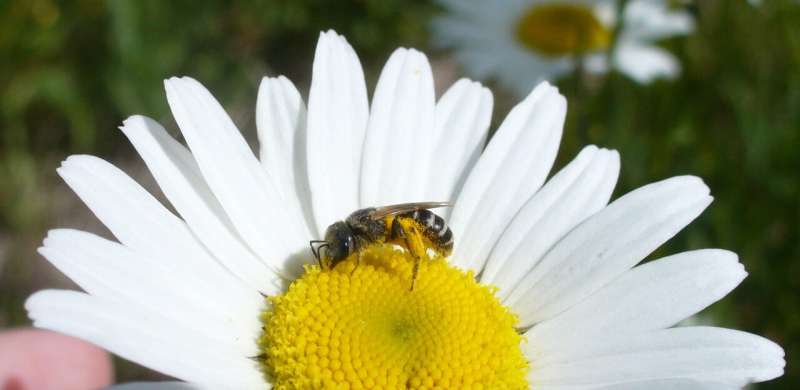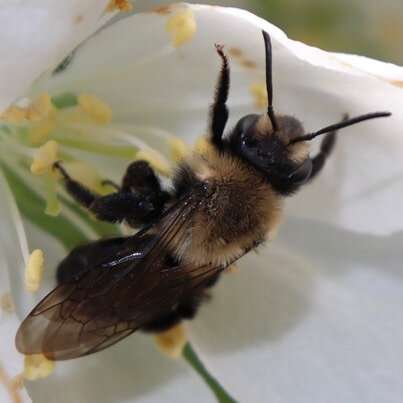As critical pollinators, bees keep our agricultural systems going—but human-caused changes to the planet heavily impact their foraging options. To help protect our food security, we need more information about bees’ own dietary requirements. Scientists writing in Frontiers in Sustainable Food Systems have studied the nutritional value of 57 types of pollen and found that bees need to forage from a variety of plants to balance their diet between fatty acids and essential amino acids.
“Despite public interest and a rise in pollinator plantings, little is known about which plant species are best suited for bee health,” said Dr. Sandra Rehan of York University, senior author. “This study aimed to better understand the nutritional value of plant species. Based on their ideal protein to lipid ratios for wild bee nutrition, we recommend that pollen species from roses, clovers, red raspberry, and tall buttercup should be emphasized in wildflower restoration projects.”
The bees’ needs
Pollen and bees are heavily interdependent: Plants need bees to spread their pollen to reproduce, and bees need pollen to eat. While bees get their carbohydrates from nectar, pollen provides proteins, lipids, and other critical nutrients. Anthropic changes to the environment which alter the availability and the properties of pollen risk malnourished bees.
Bees especially need to consume high-quality foods containing non-esterified fatty acids like omega-6 and omega-3. Without these nutrients, bees live shorter lives, have weaker immune systems, and are less able to cope with environmental stressors—but if bees consume them in the wrong ratio, they experience cognitive problems. Bees also need essential amino acids, which are necessary for cognitive health and reproduction—but if they eat too much, they may be more susceptible to certain parasites.

To understand which plants are best for bees, the scientists collected pollen samples from 57 species found in North America, either from fresh flowers in the wild or from flowers dried in the lab. They chose the plant species based on their importance to species of wild northeastern bee and their prevalence. The pollen was processed and analyzed for levels of different amino acids, non-esterified fatty acids, and protein to lipid and omega-6:3 ratios, to determine which plants were best for bees.
The scientists also investigated whether closely related species of plant provided similar nutritional benefits, and whether species that had been introduced to the area where they were collected were less nutritious than endemic species.
Healthy eating habits
In general, plants from the same family offered bees quite different nutrients, with the exception of essential amino acids. Plants from the cabbage family, the legume family, and the daisy family all had similar levels of essential amino acids compared to other plants within the same family. Daisies, a very important plant for foraging bees, boasted particularly high levels of essential amino acids. Interestingly, plants that were high in essential amino acids were relatively low in non-esterified fatty acids, and vice versa.

“There is a potential tradeoff between fatty acid and amino acid content within pollen, suggesting that a diverse floral diet may benefit bees more than a single pollen source,” said Rehan. “No one plant species is optimal for generalized wild bee health.”
The scientists’ results indicated that feeding from many different flowers is best for most bees, and that feeding from endemic species of plant offers no nutritional advantage. Most pollen species contain most of the necessary nutrients, but to get the optimal levels of nutrients in their diets, bees would need to forage from several different plant species. The scientists suggested that this diversity of nutritional content reflects the diverse needs of different species of bees, especially the specialist species that favor particular plants. A wide variety of sources of nutrition with different properties means that all bees can forage on the plants that feed them best.
“We hope this work will help inform flowering plant selections for pollinator gardens,” said Rehan. “But here we examined only 57 plant species, and there are thousands to examine to understand nutritional profiles. We hope this will inspire future similar research as well as follow-up studies on the preference and survival of bees on different diets.”
More information:
Khara W. Stephen et al, Dietary Foundations for Pollinators: Nutritional Profiling of Plants for Bee Health, Frontiers in Sustainable Food Systems (2024). DOI: 10.3389/fsufs.2024.1411410
Citation:
The plants bees need to maintain a healthy diet have been revealed (2024, June 26)
retrieved 26 June 2024
from https://phys.org/news/2024-06-bees-healthy-diet-revealed.html
This document is subject to copyright. Apart from any fair dealing for the purpose of private study or research, no
part may be reproduced without the written permission. The content is provided for information purposes only.

